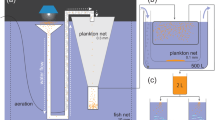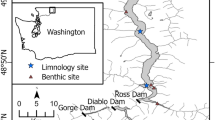Abstract
Age-0 brown trout, Salmo trutta, inhabit shallow and slow-flowing habitats where they can easily maintain stationary swimming positions. However, recent results have shown that they use deeper and faster habitats during daylight than at night, suggesting the occurrence of a nocturnal movement toward stream-margin habitats. Experiments were conducted to describe precisely when this diel pattern of habitat use appears during ontogeny. In two indoor channels, free-embryo brown trout were deposited under the gravel. When emerging, alevins were free to choose between margin (2 cm deep, 0-2 cm s-1) or deep habitat (12 cm, 2-4 cm s-1), or to leave the channel (upstream or downstream). During the week of emergence, upstream and downstream catches, fish habitat use (deep habitat or margin), and fish behavior (resting or swimming) were measured by direct observations and trap counts. Three treatments were performed: (1) fish artificially fed on drifting invertebrates, (2) fish exposed to predators (bullhead, Cottus gobio), and (3) control channels (no food, no predator). In control and food channels, a diel pattern of habitat use was observed 1-2 days after the emergence started. Most fish rested in the margin at night, whereas they moved towards the deep habitat during daylight to hold stationary swimming positions. In the presence of bullhead, most trout were cryptic, and visible fish stood in the margin during both daylight and at night. The importance of predation risk and foraging behavior on the ontogeny of the diel pattern of habitat use is discussed. Results support the direct development without larva from free-embryo via alevin in brown trout.
Similar content being viewed by others
References cited
Balon, E.K. 1975. Terminology of intervals in fish development. J. Fish. Res. Board Can. 32: 1663–1670.
Bardonnet, A., P. Gaudin & J.E. Thorpe. 1993. Diel rhythm of emergence and of first displacement downstream in trout (Salmo trutta), Atlantic salmon (S. salar) and grayling (Thymallus thymallus). J. Fish Biol. 43: 755–762.
Bardonnet, A. & M. Héland. 1994. The influence of potential predators on the habitat preferenda of emerging brown trout. J. Fish Biol. 45(Suppl. A): 131–142.
Campbell, R.F. & J.H. Neuner. 1985. Seasonal and diurnal shifts in habitat utilized by resident rainbow trout (Salmo gairdneri) observed in western Washington Cascade Mountain streams. pp. 38–49. In: Olson & White (ed.) Proceeding of Symposium on Small Hydropower and Fisheries, American Fishery Society, Denver.
Copp, G.H. & P. Jurajda. 1993. Do small riverine fish move inshore at night? J. Fish Biol. 43(suppl. A): 229–241.
Fausch, K.D. 1984. Profitable stream position for salmonids: relating growth rate to net energy gain. Can. J. Zool. 62: 441–451.
Gerking, S.D. 1994. Feeding ecology of fish. Academic Press, San Diego. 416 pp.
Grant, J.W.A. & D.L. Kramer. 1990. Territory size as a predictor of the upper limit to population density of juvenile salmonids in streams. Can. J. Fish. Aquat. Sci. 47: 1724–1737.
Greenberg, L.A. 1992. The effect of discharge and predation on habitat use by wild and hatchery brown trout (Salmo trutta). Regul. Riv. Res. Manag. 7: 205–212.
Greenberg, L.A., E. Bergman & A.G. Eklöv. 1997. Effects of predation and intraspecific interactions on habitat use and foraging by brown trout in artificial streams. Ecol. Freshwat. Fish 6: 16–26.
Harris, D.D., W.A. Hubert & T.A. Wesche. 1992. Habitat use by young-of-year brown trout and effects on Weighted Usable Area. Rivers 3: 99–105.
Heggenes, J. & T. Traaen. 1988. Downstream migration and critical water velocities in stream channels for fry of four salmonid species. J. Fish Biol. 32: 717–727.
Héland, M. 1980. La dévalaison des alevins de truite commune, Salmo trutta L. II — Activité des alevins dévalants comparés aux sédentaires. Annales de Limnologie 16: 257–254.
Helfman, G.S. 1989. Threat-sensitive predator avoidance in damelfish-trumpetfish interactions. Behav. Ecol. Sociobiol. 24: 47–58.
Hubert, W.A., D.D. Harris & T.A. Wesche. 1994. Diurnal shifts in use of summer habitat by age-0 brown trout in a regulated mountain stream. Hydrobiologia 284: 147–156.
Keefe, M. 1991. Chemically mediated avoidance behavior in wild brook trout, Salvelinus fontinalis: the response to familiar and unfamiliar predaceous fishes and the influence of fish diet. Can. J. Zool. 70: 288–292.
Metcalfe, N.B., F.A. Huntinford & J.E. Thorpe. 1987. The influence of predation risk on the feeding motivation and foraging strategy of juvenile Atlantic salmon. Anim. Behav. 35: 901–911.
Peňáz, M. 1975. Early development of the grayling Thymallus thymallus (Linnaeus, 1758). Acta Scientiarium Naturalium Academiae Scientiarum Bohemoslovacae Brno 9: 1–35.
Roussel, J.-M. & A. Bardonnet. 1995. Activité nycthémérale et utilisation de la séquence radier-profond par les truitelles d'un an (Salmo trutta L.). Bull. Fr. Pêche Piscic. 337/338/339: 221–230.
Roussel, J.-M. & A. Bardonnet. 1996. Changements d'habitat de la truite (Salmo trutta) et du chabot (Cottus gobio) au cours du nycthémère. Approches multivariées à différentes échelles spatiales. Cybium 20: 43–53.
Roussel, J.-M. & A. Bardonnet. 1997. Diel and seasonal patterns of habitat use by fish in a natural salmonid brook: an approach to the functional role of the riffle-pool sequence. Bull. Fr. Pêche Piscic. 346: 573–588.
Sempeski, P. & P. Gaudin. 1995. Size-related changes in diel distribution of young grayling (Thymallus thymallus). Can. J. Fish. Aquat. Sci. 52: 1842–1848.
Zil'ukas, V.J., M. Peňáz & M. Prokeš. 1983. The post-hatching steps in the early ontogeny of Coregonus peled. Folia Zool. 32: 85–93.
Author information
Authors and Affiliations
Rights and permissions
About this article
Cite this article
Roussel, JM., Bardonnet, A. Ontogeny of Diel Pattern of Stream-Margin Habitat Use by Emerging Brown Trout, Salmo Trutta, in Experimental Channels: Influence of Food and Predator Presence. Environmental Biology of Fishes 56, 253–262 (1999). https://doi.org/10.1023/A:1007504402613
Issue Date:
DOI: https://doi.org/10.1023/A:1007504402613




